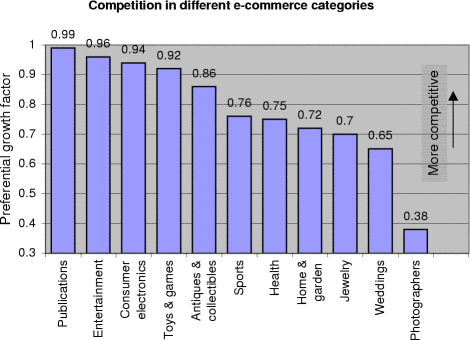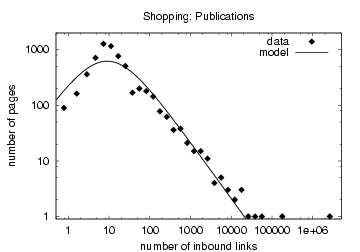Modelling the Web.

Just came across an interesting 'Power Law' paper, published by a team at NEC, which offers some thought-provoking data: "NEC researchers discovered that the degree of "rich get richer" or "winners take all" behavior varies in different categories and may be significantly less than previously thought." The key is competitiveness: in very competitive scenarios (NEC looked at ecommerce sites) 'preferential attachment' resulted in distributions that were very close to power law. But, in less competitive environments, the distributions moved steadily away from power law. In fact, deviation from power-law distribution becomes an index for competitiveness. I wonder what the Weblog index looks like? The team also pointed out that 'preferential attachment' did not prevent the rapid rise of a new star (they cite Google)... [Chris Gulker]
|
This paper makes a bold claim: "The model accurately accounts for the true connectivity distributions of category-specific web pages, the web as a whole, and other social networks."
Now its known that link structure drives traffic and traffic in e-commerce drives revenues. The chart to the right (right most point being Amazon) is a clear example of a Power-law in effect. By this example, the business of the net is in the hands of the few.
Aside from a fit and viral node's unlikely emergence, this is the world we live in. Or is it... |
 |
 |
In "less competitive" markets, such as the one to the right for photographers, the distribution is less skewed. NEC Researchers offer geographic concentration as a possible reason for this decentralization.
But I believe the structure of the net is changing because the cost of sustained entry has fallen. Blogging, Web Services and other decentralized models allow new nodes to develop linkages at a lower cost. And these links aren't just driving traffic, they are conversations -- Micro-content forming micro-markets.
As the Net evolves, the definition of a link becomes more refined, the notion of Local blurs and the emergent pattern may trend towards more shared opportunity. |
Pervasive Computing: You Are What You Compute.
The annual Cyberposium conference at Harvard Business School looked at new markets made possible by pervasive computing on January 18, 2003. Here are some selected quotes.
Tiny computers that blend into the fabric of our daily lives are starting to help us live healthier lives, predict the breakdown of our machines -- and may potentially invade our privacy.
While there are some 150 million CPUs, or central processing units, in computers worldwide, there are 7.5 billion micro controllersóchips that act as sensing and control devices.
At MIT, researchers are studying how dime-sized sensors located in light switches, medicine cabinet doors, chairs, and other invisible locations throughout the house can help with biometric health monitoring, said Stephen Intille, technology director. The goal: Keep the elderly living at home as long as possible, reducing healthcare costs and providing peace of mind to families.
In addition to commercial and industrial applications, these nearly invisible computers, and wearable computers, will help consumers with their desire to get rid of all the gadgets proliferating in their lives, said MIT professor Sandy Pentland, director of research for MIT Lab Asia. We won't carry them, we'll wear them.
We might wear them, but will they send information without our agreement?
Erik Brynjolfsson, director of the Center for eBusiness at MIT, recalled that traffic cameras scattered throughout Singapore have been used to spy on people.
But Richard Barnwell, vice president of services at Axeda, said monitoring devices used in a healthcare setting are subject to strict regulation. His company's devices, for example, cannot be placed directly on a piece of medical equipment in some cases; it must reside nearby.
So, don't worry, be happy!
Stephen Intille noted that home sensors would be used with the permission of the user. He said also that people should be more concerned with the arrival of cell phones that report your location via GPS satellite. "I'll know you are in a parking lot next to a cancer treatment center," he said.
Other subjects were discussed at Cyberposium 2003, including "biotechnology, healthcare, environment and energy, emerging technologies, entrepreneurship, and international opportunities."
Source: Sean Silverthorne, Harvard Business School Working Knowledge, February 3, 2003 [Roland Piquepaille's Technology Trends]
5:27:16 PM 
|
|
Whole System Maps. The Blogmap project continues with new maps of the December and January data of Blog Network Friendships within Ryze. Last time we revealed the structure of the network core and how it evolved over the course of one month. This time we reveal the context of the network core in the Friendships of Blog Network members -- "whole system" maps.

December 2002:
- 64/90 Tribe members had links
- 358 internal links amongst the 64
- 1444 external links to 973 other Ryze members
|

January 2003:
- 151/180 Tribe members had links
- 583 internal links amongst the 151
- 2567 external links to 1693 other Ryze members
|
Both maps reveal the Blog Network to be open. Some network structures are relatively closed, a sign of an insular community. Ron Burt, a leading network expert, explains that a tightly closed network "amplifies predispositions, creating a structural arthritis in which people cannot learn what they do not already know"[PDF...][Orgnet].
For example, Valdis Krebs recently used the "book buddy" data that a major online book retailer generates through collaborative filtering. This strikingly revealed two closed networks that could be categorized as liberal and conservative in a bow tie pattern.

Social Network Analysis, amongst other things, looks for patterns of weakness such as the bow tie above or network holes. A bow tie pattern in an organization could spell its death. But there are also strengths in a closed network. If a group has dense internal ties (short path lengths and high clustering), information flows more directly within the core to foster agility. Purely open networks, by contrast, have more external ties. The open outreach of these networks is optimized for seeking opportunity, information and knowledge. The "golden ratio" of internal:external ties for network structure for an organization remains unknown. [Ross Mayfield's Weblog]
5:11:21 PM 
|
|
Proxim's Maestro: Maestro is a new system from Proxim that pulls together all kinds of network wireless and mobile services, including voice, into a single management system that expands on what they've offered for several years with Harmony. Their release says: A key component of the Maestro architecture is the distributed deployment wireless-enabled switches at the edge of the network that integrate advanced mobility, security, network management, voice-over-WLAN, and power-over-Ethernet services. Maestro's "self aware" learning network software creates a wireless LAN that constantly monitors network growth and user density, dynamically adjusting bandwidth, access control, quality of service, and other parameters as mobile users roam throughout the enterprise. The prose is a little breathless, but I've talked to Harmony users who find that that predecessor system does offer many of these benefits for WLAN deployment and management. Later in the press release, it's noted that Maestro works with a variety of equipment, which might be the expansion of something great: heterogeneous WLAN equipment management. This isn't offered by anyone but AirWave at the moment. [80211b News]
5:10:28 PM 
|
|
© Copyright 2003 Mark Oeltjenbruns.
|
|
|
